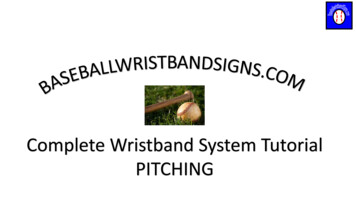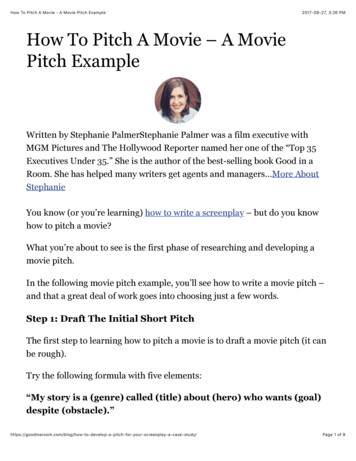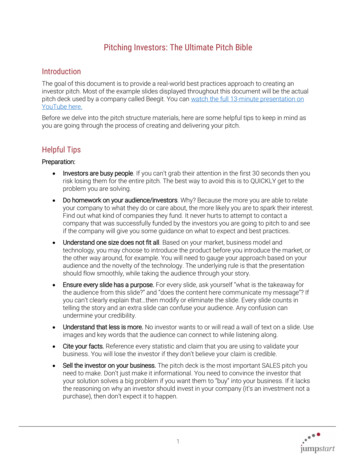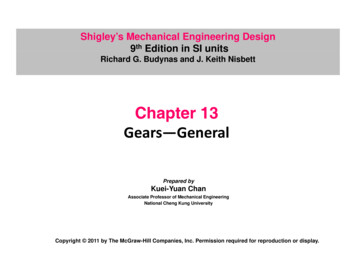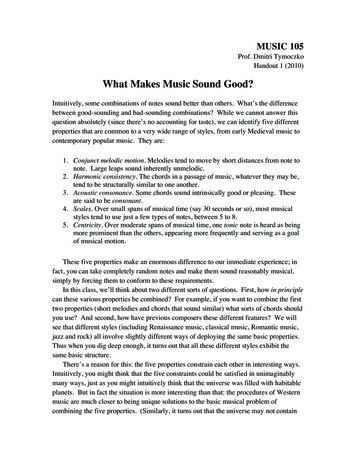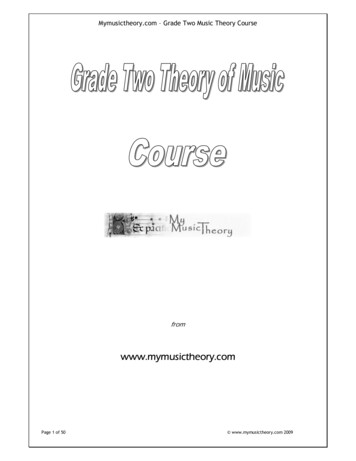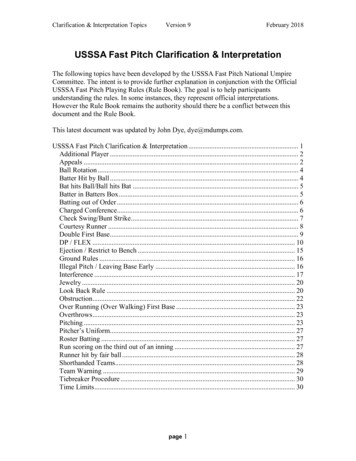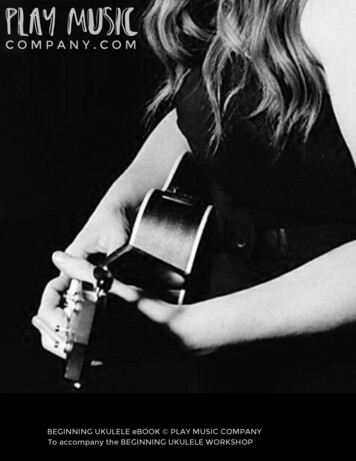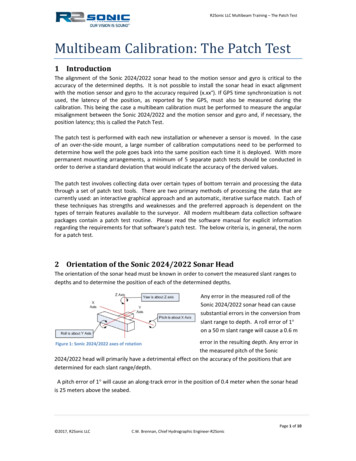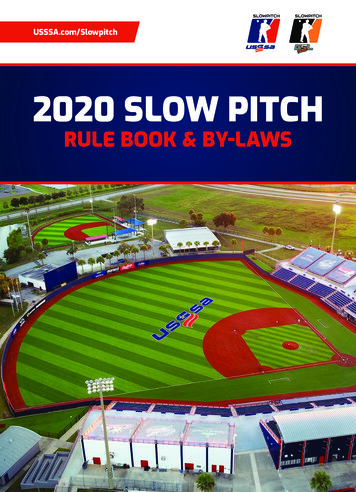
Transcription
USSSA.com/Slowpitch2020 SLOW PITCHRULE BOOK & BY-LAWS
2020 Official Slow Pitch RuleBook and National By-lawsOfficial Slow Pitch Softball Rules Adopted,Published and Distributed byUSSSA LLC5800 Stadium Parkway, Viera, FL 32940Telephone (321) 697-3636 Fax (321) 697-3647www.usssa.comAll Rights Reserved. No part of this book may be reproduced or utilized inany form or by any means without written permission from the publisher.Copyright 2020USSSA LLC1
ALL RIGHTS RESERVEDUSSSA BOARD OF DIRECTORSExecutive Director & CEODon DeDonatis IIIChairman of the BoardRick FortunaBoard MembersKevin NaegeleJoey OdomCraig ScrivenUSSSA SLOW PITCH NATIONAL COMMITTEEBrian Wegman, National Director of Slow PitchSean Melvin, Committee ChairmanCharles Beckwell, Slow Pitch National Umpire-in-ChiefKevin Naegele, Board of Directors RepresentativeStrojan Kennison, Director of Conference USSSAGary GoddenJohn HickeyGreg HuchingsonAndy Purcell2
USSSA AND GSL SLOW PITCH SOFTBALLThe Slow Pitch Softball GameOfficial Playing Rules11 Inch and 12 Inch GamesCopyright USSSA 1968-2020USSSA’s online Slow Pitch Rule Book is located at www.usssa.com.The online rule book supersedes the printed edition andwill contain any updated rule or by-law changes.NOTE: all new rule changes are screened in gray throughout the rule book.ÚThis marking means change in wording or numbering for clarification only.NOTE: Use of the word “he” in this publication is intended to include both the masculineand feminine genders unless otherwise noted.FOR ALL INQUIRIES PERTAINING TO PLAYINGRULE INTERPRETATIONSContact: Charles Beckwell52835 Hayes RoadShelby Township, Michigan 48315E-mail: Charles.beckwell@usssa.comIF AN UNUSUAL OR DISPUTED PLAY OCCURS IN A GAMEdescribe the incident in detail and email Charles Beckwell atCharles.beckwell@usssa.com for an answer or interpretation.Should you wish to have an OFFICIAL RULE BOOK, contactUSSSA at 800-741-3014 to order. Rule Books are 5.00 each plus shipping.3
Changes to the 2020 Edition USSSA/GSL Playing Rules2020 RULE CHANGESRULE l PLAYING FIELD Sec. 5 page 8: Further, the following batter’s box guidelines will be used:the batter must set up with his back foot no further forward than home plate. Any forward stride will beallowed. The batter will be called out, when either one or both of his feet are in contact with the groundCOMPLETELY outside the lines of the batter’s box in front of home plate or when his foot is in contactwith home plate while contact is made with the ball. Any batter, who runs forward through the batter’sbox to hit a ball will be judged in or out of the box at the time they contact the ball. (SEE: ILLEGALLYBATTED BALL Rule 3 page 20)RULE 2. EQUIPMENT Sec. 3 B2 e page 15: e. 12” Pro M Ball. Approved for use.RULE 3. DEFINITIONS page 23: TEMPORARY FENCE The playing field cannot be expanded bymoving any temporary structure. All rules that govern when a player is in or out of play will be judged bythe original position of the temporary fence.RULE 4. THE GAME Sec. 8 E FFECT Sec. 8 page 27 RULE 11. USSSA-GSL RULE DIFFERENCESpage 60: The following are home run limitations per game and per team, by program.Men’s Major16Men’s Class AA12Men’s Class A10Men’s Class B8Men’s Class C5Men’s Class D3Men’s Class E1RULE 7 BATTING Sec. 2 D 1 page 39: THE BATTER IS OUT IF:D. He has a second strike.Note: The batter is out on 2 strikes and walks on 3 balls.1. He hits first foul after one strike, then the ball is live.RULE 9. BALL IN PLAY AND BALL DEAD Sec. 2F. page 52: THE BALL IS LIVE AND INPLAY:F.When a fly ball is legally caught, Fair or Foul. (unless it is the first foul caught after one strike.)Sec. 3L page 53: THE BALL IS DEAD AND NOT IN PLAY:L. When the batter hits a first foul after one strike. (See 7-2D)RULE 12. MEN’ S CLASS “B,” “C,” “D,” AND “E” PROGRAMS Sec. 2 page 62; RULE 13.WOMAN’S PROGRAM Sec. 2; and RULE 14. MIXED TEAM RULES Sec. 5 page 63:the Tournament Director has the option of permitting the following: on a fair fly ball hit over the fence fora home run, the batter and all base runners are credited with a score. The batter and any runner on base donot need to advance and touch the bases. They should go directly to the dugout area. This would eliminateany base running appeals. This includes the four-base award.RULE 13. WOMEN’S PROGRAM Sec. 2 page 62: In the Women’s program, the Tournament Directorhas the option of permitting the following: on a fair fly ball hit over the fence for a home run, the batterand all base runners are credited with a score. The batter and any runner on base does not need to advanceand touch the bases. They should go directly to the dugout area. This would eliminate any base runningappeals. This includes the four base award.AMERICANS WITH DISABILITIES ACT page 67:4
PLAYING RULES TABLE OF CONTENTSRULE 1. THE PLAYING FIELD.7RULE 2. EQUIPMENT.8RULE 3. DEFINITIONS.18RULE 4. THE GAME.24RULE 5. THE PLAYERS AND SUBSTITUTES.31RULE 6. PITCHING RULE.35RULE 7. BATTING.38RULE 8. BASERUNNING.42RULE 9. BALL IN PLAY AND BALL DEAD.51RULE 10. UMPIRES.54RULE 11. GSL-USSSA RULE DIFFERENCES.59RULE 12. MEN’S B, C, D, AND E.62RULE 13. WOMEN’S.62RULE 14. MIXED.63INDEX TO RULES.64Note: Additional rules and information can be found on usssa.com(Policy & Procedures) for the following programs as well as under“Additional Playing Rules Not Found In USSSA Rule Book” Men’s Major/Conference USSSAMen’s ABlack AmericanCorporateHispanicLaw Enforcement/FireMastersMilitary5YouthNative AmericanIndoorSlow Pitch Overhand SoftballSixteen Inch RulesOne Pitch RulesScoring Rules
OFFICIAL USSSA AND GSLSTANDARD PLAYING FIELD DIMENSIONS HOME PLATE AREA3'6"5 1/2'6"17"12"8 1/2"2 1/2'3'3'91' 11"65'65'24" x 6"65'3'3'X10'7''10'Commitment Line8'Scoring Plate8' 5"610'ACO1032'6"CHESBO50'65'
RULE 1. THE PLAYING FIELDSec. 1. THE PLAYING FIELD is the area where the ball may be legally played orfielded. The field shall be an area within an established minimum radius from home plateto the far boundaries between the foul lines.Sec. 2. SPECIAL GROUND RULES may be made by Tournament Directors when thefield is less than the official minimum dimensions, which are:A.In 12 inch the radius distance is 300 feet for men.B. In Women’s Class “A” and “B,” the radius distance will be a minimum of275 feet to a maximum of 325 feet distance for National or World Tournamentplay. Temporary fences cannot be used if a permanent outfield fence is present.C. In Women’s Class “C” and “D,” the radius distance will be a minimumof 250 feet to a maximum of 325 feet fence distance for Regional, National, orWorld Tournament play.EFFECT Sec. 2 A-C. It is optional at the state program level that when an outfield fence orobstruction less than legal radius is of such height to warrant consideration, a TournamentDirector may determine whether or not to award the batter fewer than 4 bases on a fairbatted ball that goes over the fence.Sec. 3. THE OFFICIAL DIAMONDS of the field shall be established for 11 inch and12 inch with:A. 65 or 70 foot baselines shall be used in all adult programs. Exception:Special playing rules may be adopted by the USSSA Board of Directors inselected Men’s Major, “AA” and “A” events.Example: To figure the distance from home plate to 2nd base for 70 foot basesyou multiply 70x70x2 which equals 9800 and then the square root of 9800which equals 98.99 or 98 feet 11 inches.B. Pitcher’s distances of 50 feet for both men and women along with a pitchingarea the width of the pitcher’s plate up to six (6) feet behind the back edge of thepitcher’s plate.Sec. 4. THE LAYOUT OF THE FIELD is shown in the accompanying diagram. First,select the desired location of home plate (preferably toward Southwest) and drive a stake inthe ground. This will establish the rear corner of home plate. Fasten a cord to this stake andtie knots at distances of 50, 65, 92 and 130 feet. Place this cord along a line desired and at the50 foot marker place a stake. This will be the middle of the front edge of the pitcher’s plate.Further along this cord, drive a stake at the 91 foot 11 inch mark. This will be the outsidecorner of second base. Place the 130 foot marker at the second base stake. Next, take the cordat the 65 foot marker and walk to the right until the cord it taut, both from home to first andfrom second to first, then drive a stake. This will mark the outside corner of first base. The linefrom home to first becomes the first base foul line. Again, taking the cord at the 65 foot marker,7
walk across the diamond until the cord is again taut between second and third and home andthird. Then drive a stake to establish the outside corner of third base. The line between homeand third becomes the third base foul line. Both the first and third base foul lines shall beextended to the far extremities of the field. Home plate, first, second and third bases are allcompletely within the established base lines, or diamond.Sec. 5. BATTER’S BOXES shall be provided on either side of home plate, with the insideline of this box 6 inches from home plate and parallel to its sideline. The batter’s box shall be5-1/2 feet long, extending 3 feet forward and 2-1/2 feet toward the rear, measured from thecenter corner of home plate. The batter’s box shall be 3 feet wide, thus forming a rectangle of5-1/2 feet by 3 feet. The lines marking the batter’s box are considered to be part of the batter’sbox.Further, the following batter’s box guidelines will be used: the batter must set up with hisback foot no further forward than home plate. Any forward stride will be allowed. The batterwill be called out, when either one or both of his feet are in contact with the groundCOMPLETELY outside the lines of the batter’s box in front of home plate or when his foot isin contact with home plate while contact is made with the ball. Any batter, who runs forwardthrough the batter’s box to hit a ball will be judged in or out of the box at the time they contactthe ball. (SEE: ILLEGALLY BATTED BALL Rule 3 page 20)NOTE: The measurements of the length and the width of the batter’s box begin at theoutside edge of the lines of the box.Sec. 6. THE CATCHER’S BOX shall be 10 feet long from the rear outside corners ofthe batter’s box on each side of home plate, thus forming a rectangle 10 feet long and 8 feet5 inches wide.Sec. 7. THE THREE FOOT LINE is drawn outside of and parallel to the first base foulline starting at the outside corner of first base and extending halfway toward home plate.Sec. 8. THE COACHES’ BOXES shall be established at both first and third bases, 10feet from and parallel to the base lines. They shall be 10 feet long starting at the outsidecorners of the bases and extending toward home plate. The width of the box shall be 3 feet,thus forming a rectangle 10 feet long and 3 feet wide.RULE 2. EQUIPMENTSec. 1. DUE TO RAPIDLY EXPANDING and advanced technologies of softballequipment, all new equipment introduced to the game of slow pitch softball must bereviewed and approved by the USSSA Equipment Performance and Safety StandardsCommittee. Each item approved shall be tested for one year. During this time the itemcan be further evaluated in actual game-playing situations. The USSSA reserves the rightto disapprove any equipment due to failure to meet current safety standards as set by theUSSSA Equipment Performance and Safety Standards Committee.Sec. 2. THE OFFICIAL BAT shall be round in cross section, straight in length andmeasure not more than 34 inches long, including tape or other grip additions to the bat,shall have a knob at the end of its handle, and not more than 2-1/4 inches in diameter at itslargest part. Its weight shall not exceed 31-ounces, including tape or grip addition to thebat. The bat shall have a grip of tape or some other material to facilitate holding the bat8
during the batter’s swing. The grip shall be not less than 10 inches long, nor extend to touchthe taper or barrel of the bat. All key graphics, including USSSA and BPF markings, mustbe permanent and cannot be applied as decals or by any other method that would allow thekey graphics to be easily removed or added to the bat.A. Material. THE BAT may be made of hard wood of one piece, or laminatedfrom sections of hard wood bonded together with adhesive in such a way that thegrain directions of all the pieces are essentially parallel to the length of the bat.THE BAT may also be made of aluminum or other metals, fiberglass, graphite orcomposite materials.B. Construction. The bat may be made in pieces from different materials butmust have a closed barrel end, a handle and a taper. The bat may be modular withinterchangeable parts, subject to additional safety and tampering requirements asset forth in the standard USSSA Bat Licensing Agreement. The knob portion mustbe welded or mechanically attached to the bat. Only USSSA approved bats, USSSAapproved weighted bats or USSSA approved bat weigh attachments, may be usedby the on deck batter while loosening up on the field.C.Other Criteria for Legal USSSA Bats.1. Bats will be legal for USSSA sanctioned play only if the bat ismanufactured by an approved USSSA bat manufacturer on the USSSAapproved bat manufacturer list (kept by USSSA and published and madeavailable by means including, but not limited to, the USSSA website) and hasthe new USSSA mark (kept by USSSA and published and made available bymeans including, but not limited to, the USSSA website; pictured below) onthe taper of the bat. Wood bats made on the approved USSSA bat manufacturerlist shall be legal without regard to this section E.2.USSSA MarkIMPORTANT BAT STANDARD UPDATE FOR SLOWPITCH PLAYERSBased on feedback on the timeline for use of bats carrying the current 2014 stamp,USSSA is extending the grandfather date to January 1, 2023. USSSA, along with our batmanufacturing partners, is listening to the market and is standing behind our commitmentto accommodate our USSSA players. This change will allow an additional year of playwith models carrying the current 2014 stamp.ACTION TIMELINE - USSSA SLOW PITCH6/1/2020 – Slow Pitch Bats with New 2020 SP Mark Retail Release 1st day for retail launch. Bats can ship to dealers prior to date.1/1/2023 – Stop Grandfathering Bats for Slow Pitch 2014 Stamp will no longer be accepted on the Slow Pitch field of play9
2. Any addition to the handle or knob area of a bat is altering the bat if andonly if it adds any length to the bat or adds more than half an ounce of weightto the bat. Tournament Directors at the request of USSSA National Office may,however, allow for up to an inch increase in length and up to an ounce increasein weight for an addition to the knob area that is placed on bats in a tournamentfor the purpose of gathering swing/batted ball data (such as bat speed) forUSSSA National Office, provided that the Tournament Director insures thatthe addition is securely added to the knob and will not create any significantsafety concern.D. Altered Bat Director Inspection and Suspension. A USSSA Director mayat any time ask to inspect a bat that has been brought into the location of a USSSAsanctioned event or any other USSSA facility. The owner and/or user may either:1. Withhold the bat from inspection and accept an immediate two year(automatic life for second time offenders under EI and/or E) suspension fromUSSSA sanctioned activities with no right to appeal; or,2. Allow the Director to inspect the bat and reach a conclusion as to whetheror not the bat might be altered.DI. Altered Bat Determination by Altered Bat Committee Chairman orManufacturer. If, after making the inspection of a potential altered bat, theDirector in his discretion decides that the bat might be an altered bat, the suspectedoffending owner and/or user may either:1. Withhold the bat from further examination by the USSSA Altered BatCommittee Chairman or Manufacturer of the bat and accept an immediatetwo year (up to life for second time offenders under sections E and/or EI)suspension from USSSA sanctioned activities with no right to appeal; or2. Allow the Director to send the bat to the USSSA Altered Bat CommitteeChairman and/or Manufacturer of the bat for a determination as to whetheror not the bat is altered. If the Manufacturer or the USSSA Altered BatCommittee Chairman determines that the bat has been altered, the Altered BatCommittee Chairman in consultation with the Director who inspected the batat the USSSA facility may suspend a first time offender for up to five (5) yearsfrom USSSA play. For a second time offender under E and/or EI, any suchsuspension will be for life.E. Ownership and Knowledge of Bat Being Altered. The responsibility forknowing whether a bat is altered is that of the users and the owner of the bat. Ifan individual uses an altered bat in USSSA sanctioned play or is the owner of analtered bat that is brought into a USSSA facility, the suspensions under this Rule2, Section 1 will be imposed without regard to what the individual actually knewabout the altered bat. An individual must know that his bat is not an altered bat, ifhe brings it into a USSSA facility or used it in a USSSA sanctioned activity. If not,the individual can be suspended from USSSA activities for using or owning analtered bat. The fact that the individual did not know that the bat was altered is nota factor in imposing the suspension. The only question is whether the bat is altered10
or whether the owner/user has refused to let the bat be examined to determine if it isaltered. After the Director, Altered Bat Committee and Manufacturer examinationof a bat to determine if it is altered have all been completed, or upon the decision ofthe owner/user to not allow further inspection of the bat under E or EI, above, thebat shall be returned to the owner. If no one claims to be the owner, USSSA shallretain the bat. Once the bat has been returned to the owner, no appeal can be madewith respect to whether the bat is altered or not.F. Investigation Cooperation. Any coach, manager, player or other person whofails to cooperate in the investigation by USSSA of a potential or actual altered batshall be subject to an unsportsmanlike conduct suspension. A manager or coach ofa team that has more than one of his team’s bats determined to be altered (or notallowed to be inspected upon request for an altered bat inspection under E and/or EI,above) shall be subject to an unsportsmanlike conduct suspension.G. Awards and Coach Suspensions If an owner/user chooses to submit asuspected altered bat to the USSSA Altered Bat Committee or the Manufacturerno awards will be given to the team until the bat is determined not to be altered. Ifthe bat is found to be altered, no awards or berth will be given and the team will beplaced last in the standings and the listed manager and coaches may be suspendedfor unsportsmanlike conduct.H. Participation in, Profits from, or Encouraging the Altering of USSSAMarked Bats. Any one who participates in, profits from, or encourages the alteringof USSSA marked bats shall be suspended indefinitely from all USSSA activities,until the offending party has satisfied all requests of the Altered Bat Committee withrespect to his altered bat activities including but not limited to publicly swearingunder penalties of perjury to never again participate in, profit from, or encourage thealtering of USSSA marked bats. Violation of such an oath shall result in permanentsuspension from all USSSA activities.I. Compression Testing. Failure of a USSSA approved compression testingdevice test shall result in the offending bat being removed from play for theduration of the tournament or league game, not longer without the permission ofthe owner/user—such as in the case of an allowed USSSA altered bat determinationunder section EI. Multiple failures of such USSSA compression testing may in thediscretion of USSSA be viewed as unsportsmanlike conduct of the owner/user,coaches, manager and team.J. Custom Bats. No approved manufacturer may make a custom USSSA bat for aplayer or a team. All USSSA marked bats made by a USSSA approved manufacturermust be available to the public for purchase. Individualized graphics (such as a teamname, different color, player name or number only changes for a team or player),however, do not constitute custom bats for purposes of this section K.K. Worn/Abused/Damaged/Foreign Substance Bats Not Allowed in USSSASanctioned Play.1. No bat is legal for USSSA sanctioned play, if it is damaged in any way.Damaged bats include those with damage to the knob or end cap, those which11
have loose knobs or end caps, and those with cracks or dents in the bat material.For example, if the end cap is in any way loose or appears damaged, the batshould be removed from play for being a damaged bat. If an end plug has comeout or the knob has come off, the only way that such bat is legal in USSSAplay, is if the knob or end cap is replaced by the manufacturer. Replacement byanyone else results in an altered bat with potential suspension for the owner/user of the bat.2. No bat is legal for USSSA sanctioned play, if any of the graphics of thebat have worn off. For example, even if the only graphics that have worn offare not key graphic information and are only items such as the patent no., amanufacturer logo, or the approval mark of another association, the bat shouldbe removed from play for being too worn. NOTE: The bat shall not haveexposed rivets, pins, rough or sharp edges, or any form of exterior fastener thatwould present a hazard. Bats shall be free of rattles, dents, burrs and cracks.3. No bat is legal for USSSA sanctioned play, if the paint has been wornthrough and the actual bat material is showing. For example, if at the end ofthe barrel next to the taper where there are no graphics the bat paint is worn offand the underlying bat material is exposed, that bat should be removed fromplay for being too worn.4. No bat is legal for USSSA sanctioned play, if there is a foreign substanceon the barrel or taper of a baseball or softball bat. Foreign substances includedamong other substances, pine tar, stick-em type products and even dirt ormud, but only if the substance adds to the thickness of the barrel or coverskey graphic information such as the USSSA 1.20 BPF mark, the serial numberof the bat, the model or manufacturer name, official softball, etc. Players areresponsible for their equipment and must clean such substances off of theirbats so that the substance does not add to the thickness of the bat or obscureany key graphic information about the bat. For example, while bats will surelyget dirt on them under normal use and may have pine tar added to the grip, ifthe dirt or pine tar obscures key graphic information or adds to the thickness ofthe bat, such bats cannot be used in USSSA play until the dirt or pine tar hasbeen removed to the extent necessary to make all such key graphic informationreadable and the bat not have increased thickness. If key graphic informationabout a bat cannot be read, the bat should not be used in USSSA play.5. If any removed bat under these section L rules is brought back into playat any USSSA sanctioned event at any time, the owner and user of such batmay be suspended for up to one year for unsportsmanlike conduct. And if theforeign substance or the wear/abuse/damage is apparent enough that the battershould have been aware of it, the batter may be suspended for bringing sucha bat into the batters box without having been warned in advance. Playersare responsible for their equipment and must not use equipment that is evenpotentially illegal for use in USSSA sanctioned play.6. In addition to the player being suspended for unsportsmanlike conduct,coaches of youth teams may also be so suspended when their players attempt to12
bat with such bats. Also, coaches of adult teams which have multiple offensesunder this rule may also be so suspended for failing to have his team followUSSSA equipment rules. Please be reminded that unsportsmanlike conductmay result in a game or tournament suspension in the discretion of the umpireor tournament director and up to a year suspension in the discretion of the statedirector.L. Youth Player Altered Bats. The parents or legal guardians of a youth playersuspended under section E and/or EI shall be suspended for life from all USSSAsanctioned activities. As such, the player even after his suspension has endedunder E and/or EI cannot participate in USSSA sanctioned activities until the playeris 18 years old. In addition to any other penalties under this Rule 2.1, any coach ormanager of a youth team that has more than one suspension imposed under sectionsE and/or EI will be suspended from all USSSA activities for life.M. 1. League directors may change USSSA Rules in very limited circumstances,where in the league director’s discretion and judgment such a rule change is inthe clear best interests of the league, its players, and USSSA. Such league rulechanges, however, cannot reduce the right of USSSA Licensees to have theirproducts allowed in USSSA play or allow non-licensed bats or balls to be usein USSSA sanctioned play.Sec. 32. Any material league rule change under this Rule, however, must withina reasonable time period be sent by the league director who is authorizing thechange to the USSSA Board of Directors or a Committee designated by theBoard at sprules@usssa.com and to the appropriate State Director, each ofwhich may, in their discretion, overrule any USSSA league rule changes.A. THE OFFICIAL BALL to be used shall be of a spherical design with asmooth surface. The center or core of the ball shall be of a material and designtraditionally used to make softballs or other materials or design as approved by theUSSSA. The cover shall be of horsehide, cowhide or other material approved by theUSSSA and shall be cemented to the core and stitched with cotton, linen or nylonor any other material approved by the USSSA. A molded cover ball or a moldedball without a separate cover, or a multiple layer core design or multiple materialcore design, may be approved by the discretion of the USSSA on a case by casebasis. The thread shall be in either flat seam or concealed stitch type which gives aflat surface. The stitch color must be blue. The internal composition of the core andthe material of the cover must be clearly printed on the ball and the words “OfficialSlow Pitch Softball” must be clearly printed on the ball.Note: The performance of a softball by reducing the temperature below that ofgame conditions is unsportsmanlike conduct.B. In addition to standard brand identification, balls may have additionaldecorative graphics that cover, in combination with all other graphics, not morethan 40% of the surface of the ball. Such additional graphics may not be brandidentification, advertising or words.13
Ú1. Size and weight: The completed 12” ball shall have a circumference of12” /- 1/8” and weigh 6.4 ounces /- 0.2 oz. The seam shall have not lessthan 88 stitches in each cover, or 88 simulated stitches in molded cover balls.The completed 11” ball shall be 11” /- 1/8” in circumference and weigh 5.85ounces /- 0.2 ounces and shall otherwise be proportional to the 12” ball.2.Name, Logo, COR, and Compression 12” Ballsa. There shall be no COR or compression information written on theball, marketing materials or packaging. Manufacturers may have theirname and logo in any color.b.12” Classic M Ball:i.shall have an optic yellow coverii.shall have “USSSA CLASSIC M” in 1/8” letters and theUSSSA logo with a 1-1/8” diameter;iii. shall have lettering and logo in blue color and such letteringand logo shall be applied to be indelible;iv.shall have a COR of 40 or less under the ASTM test used underthe USSSA Softball Ball License Agreement andv.shall have a compression of not more than 325 pounds underthe ASTM test used under the USSSA Softball Ball LicenseAgreement.c.12” Stadium M Ball:i.shall have an optic yellow coverii.shall have “USSSA STADIUM” in 1/8” letters and the USSSAlogo with a 1-1/8” diameteriii. shall have lettering and logo in gray color and such letteringand logo shall be applied to be indelibleiv.shall have a COR of 47 or less under the ASTM test usedunder the USSSA Softball Ball License Agreement andv.shall have a compression of not more than 480 pounds andnot less than 420 pounds under the ASTM test used under theUSSSA Softball Ball License Agreement.vi.shall be used only in the Men’s Major Programd.12” Classic Plus Ball:i.shall have an optic yellow coverii.shall have “USSSA Classic Plus “ in 1/8” letters and theUSSSA logo with a 7/8” diameter14
iii. shall have
play. Temporary fences cannot be used if a permanent outfield fence is present. C. In Women's Class "C" and "D," the radius distance will be a minimum of 250 feet to a maximum of 325 feet fence distance for Regional, National, or World Tournament play. EFFECT Sec. 2 A-C. It is optional at the state program level that when an outfield .

